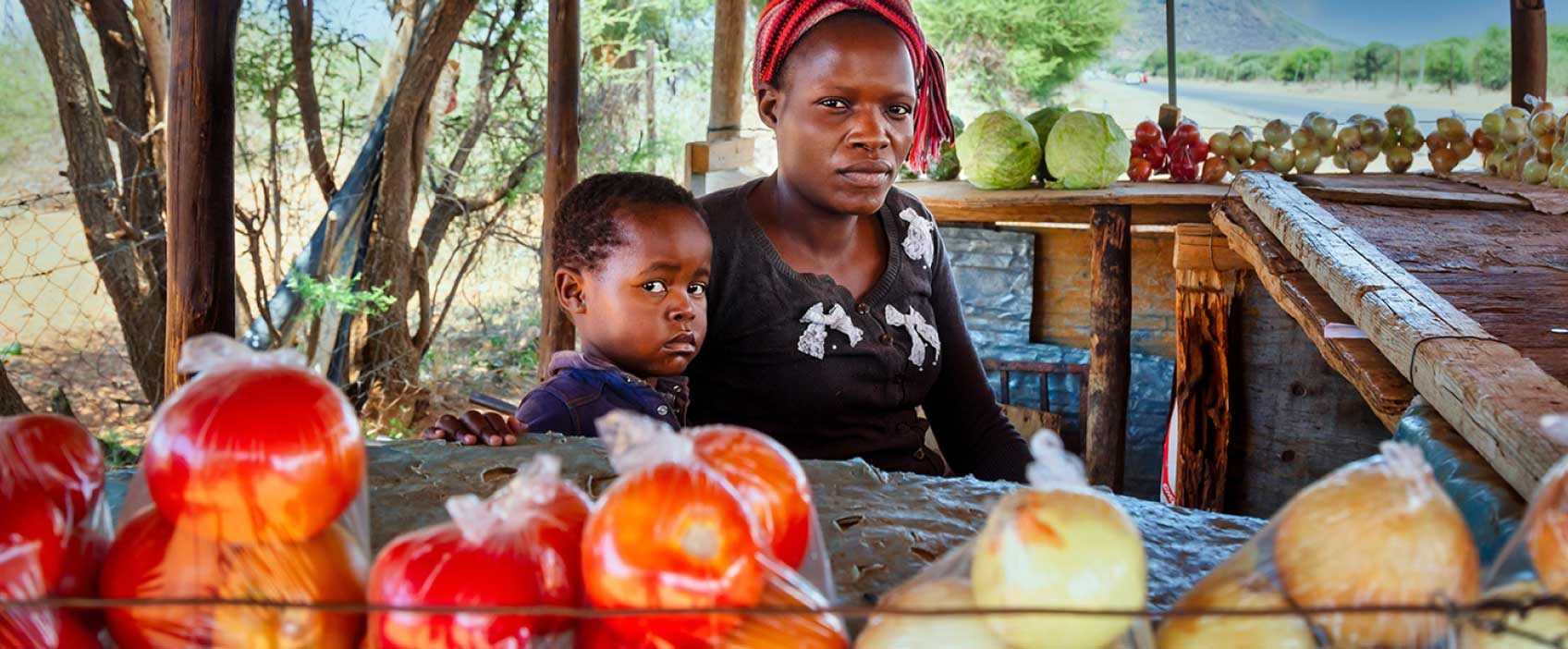
Publications and Datasets
IFPRI publications provide evidence-based insights and analysis on critical issues related to policies for food systems, food security, agriculture, diets and nutrition, poverty, and sustainability, helping to inform effective policies and strategies. Materials published by IFPRI are released under a Creative Commons license, and are available for download. IFPRI authors also publish in external sources, such as academic journals and books. Where possible we provide a download link for the full text of these publications.
Featured Publications
Journal Article
Preventing relapse from wasting: the role of sociodemographic, child feeding, and health care determinants and of wasting prevention interventions in Burkina Faso and Mali
2025Brander, Rebecca L.; Toure, Mariama; Becquey, Elodie; Ruel, Marie T.; Leroy, Jef L.; Huybregts, LievenJournal Article
How much do our neighbors really know? The limits of community-based targeting
2026Trachtman, Carly; Permana, Yudistira Hendra; Sahadewo, Gumilang AryoJournal Article
Policy and regulation in seed sector development for vegetatively propagated crops: Insights from Kenya, Nigeria, and Vietnam
2025Spielman, David J.; Gatto, Marcel; Wossen, Tesfamicheal; McEwan, Margaret; Abdoulaye, Tahirou; Maredia, Mywish K.; Hareau, GuyExplore Our Latest Publications
Important: This website search is limited to displaying the 100 most recent results to ensure optimal performance. For access to the complete archive of IFPRI publications and resources, please visit the IFPRI Institutional Repository at https://cgspace.cgiar.org/.
By Title By Author By Country/Region By Keyword
Journal Article
The effect of teacher training and community literacy programming on teacher and student outcomes
Journal Article
How much do our neighbors really know? The limits of community-based targeting
Journal Article
Agricultural technology adoption and deforestation: Evidence from a randomized control trial
Journal Article
Whole maize flour could enhance food and nutrition security in Malawi
Journal Article
Buyer-side gender discrimination in bargaining: Evidence from seed sales in Uganda
Journal Article
Using a list experiment to measure intimate partner violence: Cautionary evidence from Ethiopia
Journal Article
Gender-just mitigation in the agrifood systems sector: Potential and pitfalls
Journal Article
Looks matter? Field performance and farmers’ preferences for drought-tolerant maize in Kenya
Journal Article
Policy and regulation in seed sector development for vegetatively propagated crops: Insights from Kenya, Nigeria, and Vietnam
Journal Article
Beyond the bids: Lessons from farmers’ reflections on Vickrey auctions of sweetpotato vines in Rwanda
Journal Article
Zinc distribution in structural components of high kernel‑zinc maize and its retention after milling
Journal Article
Cities and agricultural development
Journal Article
The complex economics of a complete ban on child labor in the cobalt supply chain: The case of the DR Congo
Journal Article
Traders and agri-food value chain resilience: The case of maize in Myanmar
Journal Article
Private sector promotion of agricultural technologies: Experimental evidence from Nigeria
Journal Article
Herder-related violence, labor allocation, and the gendered response of agricultural households
Journal Article
Social identity and crisis resilience in agriculture: Caste, gender, and migration in Nepal
Journal Article
The agrifood-system wage gap and structural transformation: cross-country evidence
Journal Article
What drives fast food consumption in Asian low-and middle-income countries? A narrative review of patterns and influencing factors
Journal Article
A critical approach to co-producing knowledge for development
Working Paper
Agricultural mechanization policy in Bangladesh: An assessment of the phase III support program and recommendations for reform
Journal Article
Achieving transformational sustainable land Intensification: Integrated general equilibrium and portfolio analysis for Senegal
Report
2024 IFPRI annual report
Brochure
IFPRI at a glance
Abstract
South Asia Nutrition Knowledge Initiative: Abstract digest August 2025
Working Paper
Uncovering the pathways to gender equality and women’s empowerment through agricultural research for development: Lessons from the Feed the Future innovation labs
Working Paper
Rural credit, food security, and resilience: An empirical evaluation from Kenya
Journal Article
Women’s tenure security on collective lands: A conceptual framework
Journal Article
A comparative study of the legal and regulatory dimension of seed sector development in Sub-Saharan Africa using regulatory systems maps: The case of Ethiopia, Rwanda, and Uganda
Journal Article
Agency and behavior change in agricultural research for development: New directions for guiding agri-food system transformations
…more
Ndiwa, Aurillia Manjella; Zingwena, TauraiJournal Article
Bridging the gap: Integrating crop pests and pathogens into agricultural foresight models for food security assessments
Journal Article
Perspective: Growth monitoring and promotion as an opportunity to improve early childhood development
Journal Article
Profiling Chinese entrepreneurs
Journal Article
Do estimates of women’s control over income and decisionmaking vary across nationally representative survey programs?
Opinion Piece
The famines in Gaza and other conflict areas are a moral failure
…more
Headey, Derek D.; Heidkamp, Rebecca; McCarter, Abbe; Menon, Purnima; Michaux, Kristina; Nordhagen, Stella; Silva, Lais Miachon; Verstraeten, Roosmarijn; Bhutta, Zulfiqar A.Book Chapter
Total factor productivity growth in Indian agriculture and regional convergence
Brief
Livelihoods and welfare: Findings from the eighth round of the Myanmar Household Welfare Survey (October – December 2024)
Preprint
Diet quality and obesity in women of reproductive age in Northern Tanzania: a cross-sectional study
Report
GCAN partner workshop: Report on lessons and recommendations for policy engagement and capacity strengthening
Working Paper
Banking systems, capital markets, and financing the transformation of food systems: The role of macroeconomics, regulations, and incentives
Working Paper
Kisan credit card and smallholder farmers’ economic performance in eastern India: A panel data analysis
Brief
Applying an integrated engagement model to support country-led food systems transformation: Insights from the SHiFT Initiative’s approach in Viet Nam, Ethiopia, and Bangladesh
Working Paper
Monitoring individual migration in Myanmar: December 2021 – June 2024
Brief
Advancing forest-based carbon trading in Nepal: Policy challenges and agroforestry opportunities
Working Paper
Remittance trends in Myanmar: January – June 2024
Working Paper
Developing a regional cooperation strategy for scaling up climate-smart agriculture in South Asia
Working Paper
Development readiness
Journal Article
Integrated land systems for sustainable food production and biodiversity conservation in the semi-arid to moist tropics: Stakeholder perspectives from Andhra Pradesh, India
…more
Singh, Vartika; Hareesha, A. S.; Basu, Parthiba; Bheemappa, Boraiah; Biradar, Chandrashekhar; Chatterjee, Archana; Dagam, Ramdas; Devarathna, Israel Oliver King Edwin; Gergan, Reuben; Patibandla, Vinuthna; Paul, Benjamin; Pulluri, Vamshi Krishna; Rajamani, Nandini; Ramireddy, Mounika; Siddiqui, Imran; Ramachari, Sowmithri Vadaganambi; Tampal, Farida; Udayraj, Swati; Venkateswarlu, Tata; Dicks, Lynn V.Journal Article
Designing and implementing experiments within local bureaucratic systems: A cautionary tale from an educator incentive program
Opinion Piece
Forest loss in Malawi: how having women at the table affected debates and decisions about solutions – research
Brief
Coping with crisis: Livelihood vulnerabilities and food insecurity in Sudan’s current conflict
Book Chapter
What do we know about the future of water in food systems?
Book Chapter
What do we know about the future of the environment and biodiversity in relation to food systems?
Book Chapter
What do we know about the future of agrobiodiversity in relation to food systems?
Book Chapter
What are food systems and what can we know about their future?
Book Chapter
What do we know about the future of food systems in Latin America and the Caribbean?
Book Chapter
What do we know about the future of crop pests and diseases in relation to food systems?
Book Chapter
What do we know about the future of food systems innovation?
Book Chapter
What do we know about the future of foresight modeling related to food systems?
Book Chapter
What do we know about the future of food systems in South Asia?
Book Chapter
What do we know about the future of the agrifood system in South Africa?
Book Chapter
What do we know about the future of food demand, production, and food security based on IMPACT model projections?
Book Chapter
What do we know about the future of food systems in relation to climate change?
Book Chapter
What do we know about the impacts of the next El Niño on agrifood systems?
Book Chapter
What do we know about the future of food systems in India?
Book Chapter
What do we know about the future of aquatic foods in global agrifood systems?
Book Chapter
What do we know about the future of food systems in West and Central Africa?
Book Chapter
What do we know about the future of measuring food systems?
Book Chapter
What do we know about the future of energy and food systems?
Book Chapter
What do we know about the future of poverty in relation to food systems?
Book Chapter
What do we know about the future of wheat?
Book Chapter
What do we know about the future of animal-source foods and food systems?
Book Chapter
What do we know about the future of agrifood systems in Southeast Asia?
Book Chapter
What do we know about the future of land in relation to food systems?
Book Chapter
What do we know about the future of food trade?
Book Chapter
What do we know about the future of urbanization in relation to food systems?
Book Chapter
What do we know about the future of rice in relation to food systems?
Book Chapter
What do we know about the future of diets and nutrition?
Book Chapter
What do we know about the future of roots, tubers, and bananas in relation to food systems?
Book Chapter
What do we know about the future of food systems in East and Southern Africa?
Book Chapter
What do we know about the future of food systems in Central and West Asia and North Africa?
Book Chapter
What do we know about the future of pulses in global and regional agrifood systems?
Book
What do we know about the future of food systems?
Book Chapter
What do we know about the future of gender equality in relation to food systems?
Book Chapter
What do we know about the future of food assistance?
Book Chapter
What do we know about the future of the agrifood system in Indonesia?
…more
Firdaus, Irfan Thofiq; Setyawati, Dewi; Pradesha, Angga; Yulaswati, Vivi; Beik, Irfan Syauqi; Wardhana, Irwanda Wisnu; Indarto, Jarot; Nugroho, Agus Eko; Arifin, Bustanul; Sudaryanto, TahlimBook Chapter
What do we know about the future of maize value chains in a changing climate and agrifood system?
Book Chapter
What do we know about the future of agriculture systems in China?
Book Chapter
What do we know about the future of agriculture in Argentina, Brazil, Paraguay, and Uruguay?
Brief
KhetScore: Impacts of using digital technologies to unlock credit and insurance for marginal farmers in Odisha
Opinion Piece
Why desk rejections happen and how young researchers can avoid them: Practical lessons from experience
Report
Myanmar Monthly Food Price Report – June 2025
Brief
Vegetable, fruit, and staple crop production and input use: Baseline findings from the FRESH end-to-end evaluation
…more
Kinabo, Joyce; Cunningham, Kenda; Olney, Deanna K.; Kumar, NehaReport
Essential commodities prices, availability, and market actors’ perceptions: June 2025
Opinion Piece
Sudan’s war is an economic disaster: Here’s how bad it could get
Preprint
Intimate partner violence and women’s economic preferences
Report
Is a negative US agricultural trade balance a cause for concern?
Journal Article
Genetic control of seed iron and zinc concentration in Rwandan common bean population revealed by the Genome Wide Association Study (GWAS)
…more
Okada, Moeko; Fukai, EigoBrief
Country profile – Kenya: Gender, climate change, and nutrition linkages
Report



